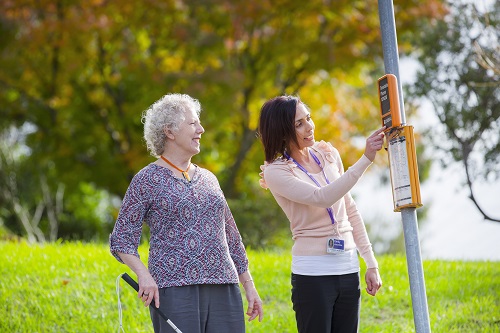Social distancing is an important part of controlling the COVID-19 pandemic, but this can be difficult to achieve for people who are blind or have low vision.
Many public spaces use visual markers to advise people where to stand or queue, while some people who are blind or have low vision may need additional support to navigate crowded places or those they are unfamiliar with.
This means people who are blind or have low vision may need assistance from others from time to time. Below are some tips for the best ways for people to approach and provide assistance for people who are blind or have low vision.
If you are a person who is blind or have low vision, we also have advice for methods you can use to stay safe in public places during COVID-19.
Supporting people who are blind or have low vision may involve some physical contact, so it is important to maintain good hand hygiene.
Offering assistance
- If you suspect somebody may need a hand, walk up, greet them and identify yourself.
- Ask people who are blind or have low vision what they want or need directly.Do not direct questions through their companions.
- You should ask "would you like some help?" or similar. The person will accept your offer or tell you if they don't require assistance.
- Not all people who are blind or vision impaired will want assistance. Don't be offended if your assistance is not required.
- Do not try to offer assistance to people who are blind or have low vision by grabbing or touching them in anyway. Always ask permission first and take direction from the person.
- Sighted guiding is a common method of assisting people who are blind or have low vision. More information about how sighted guiding works is available on our website.

Caption: People who are blind or have low vision may have difficulties following visual cues associated with social distancing.
Speaking
- Address people who are blind or have low vision by their names so they know you are speaking to them.
- Let the person who is blind or has low vision know that you have entered the room.
- Do not walk away from a person who is blind or has low vision without indicating that you are doing so.
- People who are blind or have low vision may be disadvantaged by not seeing what is happening around them. Therefore, talk about notable features or happenings in the immediate surroundings.
Giving directions
- Use ordinary language when directing or describing and be specific.
- Do not point, or say "over there."
- Direct people who are blind or have low vision to their left and right, not yours.
- In dangerous situations say "STOP" rather than "LOOK OUT”
Navigating obstacles
- Describe the surroundings and obstacles in a person's pathway (remember to look up as well as down).
- Warn of the presence of over-hangs, such as kitchen cupboards, jutting side mirrors of vehicles, or tree branches.
- Do not relocate objects or furniture without telling the person who is blind or has low vision.
- Do not leave doors ajar. Close them or open them fully.
For more information about supporting people who are blind or have low vision, call Vision Australia on 1300 84 74 66 or email info@visionaustralia.org.










